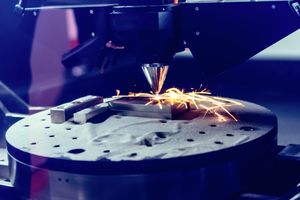KANBrief 2/23

The growing use of additive manufacturing processes, colloquially known as 3D printing, has increased the need for standards to be developed. At ISO level in particular, standards are currently being developed that impinge upon occupational health and safety.
Additive manufacturing processes are increasingly being used for the production of precision-fit components. Additive manufacturing is a generic term that includes all processes in which a machine builds up material layer by layer. A range of technologies and base materials are used, according to the application. Each of these base materials and technologies gives rise to particular hazards for workers.
As a Type A standard under the Machinery Directive, EN ISO 121001 contains essential and general requirements for risk assessment and reduction that are applicable to all types of machinery. At present, no Type C standard currently exists in the field of additive manufacturing containing detailed requirements for individual machine types, despite the fact that machines of this type have been in use in production for some time now. The current development of a possible candidate standard in the form of EN ISO/ASTM 52938-12 should therefore be welcomed. This document defines safety requirements for machines employing a laser beam and bed of metallic powder. The aim of the European stakeholders on the ISO committee is to ensure that the final standard is consistent with the EU Machinery Directive and listed under the latter. To support this objective, the KAN Secretariat was involved in preparation of the draft standard. The document is in the public enquiry phase and can be viewed through DIN’s draft standard portal, through which any stakeholder is free to submit comments on the draft text (preferably by 1 July 2023).
A number of organizations wish to use standards and similar documents to address aspects concerning the safety and health of workers at work, a well as product and machine safety. In Germany, the former are governed by a detailed body of regulations issued by the state and the accident insurance institutions. For this reason, the stakeholders represented in KAN are opposed to standards in this area other than in exceptional cases. Blocking each and every such initiative is however not realistic; where this is not possible, it is important that KAN monitor the processes with the aim of ensuring that the documents produced are defensible at least from a technical perspective.
For example, VDI standards in the 3405-6 series3 highlight the hazards associated with certain additive manufacturing processes. They contain no workplace requirements of their own; rather, as a result of an initiative by KAN, they serve as guides to application of the relevant body of state rules and regulations and those of the accident insurance institutions. This approach assures a high level of consistency in the body of regulations, and also lends itself readily to application.
At international level, too, there is considerable interest in standards governing the safety and health of workers working with additive manufacturing processes. For this reason, the KAN Secretariat also became involved in the development of ISO/ASTM 529314, which contains general workplace principles for the use of metallic materials in additive manufacturing. ISO published the standard in early 2023. It was adopted as a European standard in the parallel voting procedure and will thus be transposed in the German body of standards as a matter of course in the near future. The KAN Secretariat has lobbied for reference to be made in the document’s introduction and at other suitable points to the body of regulations applicable at national level. It is anticipated that work will begin shortly on a further document of the same kind, probably for polymer-based additive manufacturing processes.
Active participation by OSH experts in development of the relevant standards is essential if a high level of safety is to be achieved. Only then can documents be drafted in the interests of occupational safety and health, and potential problems avoided from the outset. This particularly applies to areas in which established standards are very few in number, as is the case for additive manufacturing. The KAN Secretariat will continue to monitor standardization activity in the field of additive manufacturing. However, greater involvement by further OSH experts in this new area of standardization activity is desirable – particularly experts with practical experience of the machinery concerned. Their knowledge has immense value and may be decisive in the development of further Type C standards. In Germany, responsibility lies with the Additive Manufacturing group of the DIN Standards Committee Technology of Materials.
Nicola Helfer
helfer@kan.de
1 EN ISO 12100:2011, Safety of machinery – General principles for design – Risk assessment and risk reduction
2 E DIN EN ISO/ASTM 52938-1 Additive manufacturing of metals – Environment, health and safety – Part 1: Safety requirements for PBF-LB machines;
3 VDI 3405, Additive manufacturing processes – User safety on operating the manufacturing facilities – Part 6.1:2019-11, Laser beam melting of metallic parts; Part 6.2:2021-04,
Laser sintering of polymers; Part 6.3 draft:2022-02: Resin-based manufacturing processes.
4 ISO/ASTM 52931:2023-01, Additive manufacturing of metals – Environment, health and safety – General principles for use of metallic material;